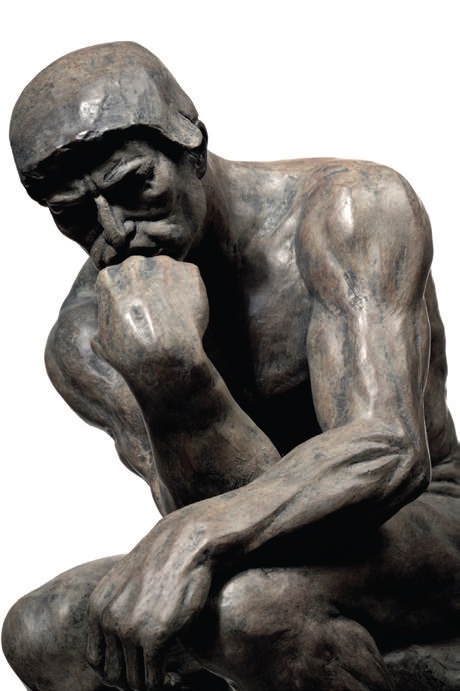The four modalities
Jerry L. Kennedy | TLT Selling Points October 2011
Discovering how your prospect makes decisions greatly improves your chances of getting to ‘Yes.’

Thinkers are one of the four decision-making types. The others are knowers, sensers and feelers.
www.canstockphoto.com
AUGUST’S COLUMN DISCUSSED the first three pieces of Tom Hopkins’ NEADS analysis: What does the prospect do Now, what does he Enjoy about what he does now and what would he like to Alter or change about what he does now? That brings us to the D in NEADS, and the spot where I modify Tom’s analysis a bit.
Tom suggests the D stands for Decision maker—make sure at this point that you’re talking to a person who can actually sign on the dotted line. I disagree because (1.) this is a little late in the process to be finding out if you’re talking to the right person and (2.) the only way you’re ever going to know whether the person you’re talking to is the decision maker is to ask him to make a decision.
My suggestion is to stop worrying about whether you’ve got the decision maker and start paying attention to how your prospect makes decisions. That’s why I think that the D in NEADS really stands not for Decision maker but for Decision-making modality.
Essentially, a prospect’s decision-making modality is the way he or she receives and processes information before making a decision. There are four modalities: thinking, feeling, knowing and sensing. All of us use all four modalities, but there is usually one that dominates the way we decide on a course of action.
At their Website,
www.emotionalintelligenceatwork.com, Jeremy Marchant and Kay McMahon described the process in an article titled, “We Make All Our Decisions Based On Feelings.” They say:
“In the processing that goes toward decision making, thinkers use data, facts and figures. They analyze and deduce. Feelers consider their emotions, and there is a sense of ‘feeling their way.’ Knowers are the intuitive ones; they may not actually know how they made the decision, but they are sure it’s right. Sensers use the input from their senses to inform them.”
Marchant and McMahon make the distinctions between the four modalities clear by relating what it would be like to have dinner at a restaurant with one of each type:
“The thinkers will read every page of the menu, check out the prices of all the dishes, check that they can afford their choice—it’s all analytical and can take some time in your average Chinese restaurant.”
“The feelers ask themselves, ‘What do I feel like today?’ They’ll recall how much they enjoyed similar dishes on previous occasions—this can take quite a lot of time, too.”
“The knowers probably knew before they got to the restaurant what they wanted and see no reason to look at the menu. The thinkers and feelers drive them mad, and their best tactic is to slope off to the bar for 10 minutes. The sensers are most swayed by seeing what’s to offer or, better still, having a taste.”
If you can remember these differences the next time you’re talking to a prospect, you’ll have the inside track on getting a Yes because you’ll be able to present your solution in a way that appeals to the prospect’s decision-making modality. But how can you tell which prospects use which modalities? If taking them to lunch isn’t possible, have a look around their office and pay attention to their speech.
See lots of piles of papers in neat stacks with tons of data on them? You’ve probably got a thinker. Bring lots of charts and graphs to support your presentation. Does she keep talking about how she’d like to “cut to the chase” and “get down to brass tacks?” Likely a knower; make your presentation quick and impactful, using bullet points instead of paragraphs.
Does he get misty-eyed when talking about the day he bought his first home? Sounds like a feeler. Tell lots of stories during your presentation. Does he want to see pictures in the brochure or touch a sample? Definitely a senser; a multimedia presentation would make his day.
If you can tune in to the decision-making modality of the prospect and design a presentation that speaks to that modality, you’re well on your way to getting the coveted Yes. Now all that remains is to finish up the NEADS analysis by creating and presenting a Solution (the S in NEADS) that exactly fits the prospect’s situation.
We’ll talk about exactly how to do that in our next article.
 Jerry Kennedy is owner of Inside Out Business Solutions, a sales and customer service training organization. To learn more sales strategies, visit Jerry’s blog at http://jerrykennedy.com or you can reach him at jerry@jerrykennedy.com
Jerry Kennedy is owner of Inside Out Business Solutions, a sales and customer service training organization. To learn more sales strategies, visit Jerry’s blog at http://jerrykennedy.com or you can reach him at jerry@jerrykennedy.com.